The turbine tank

The most remarkable trait about this Soviet MBT was its turbine, used as main motricity power. It was indeed the first conventional MBT equipped with a turbine, preceding the M1 Abrams from two years in service. It could be argued that the first turbine tank was the innovative Swedish S-tank, but the latter was not a conventional MBT by any means (more an advanced tank destroyer SPG than MBT by all standards). It was more produced than the more modern T-90 MBT and largely exported in its final version T-80U. It was the first Soviet 3rd generation MBT.
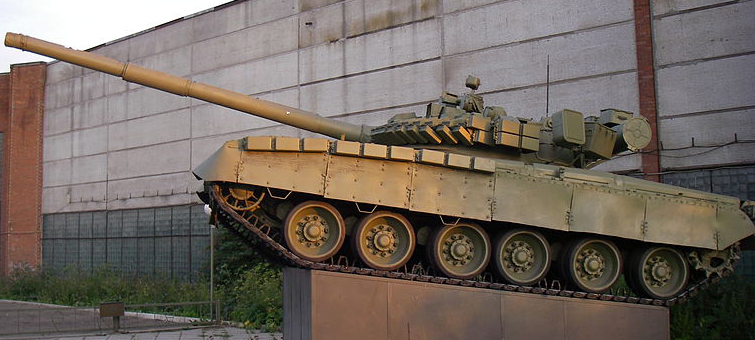
Perhaps 40 years in the making, this old concept going back to 1949 was only materialized in the 1970s and the final tank borrowed parts from the T-72 and others from the T-64. Often confounded with the latter by NATO experts at the beginning, it has the same family traits of contemporary Soviet MBTs but was by any means a specific branch of MBTs. Much costlier than the T-72, it was, like the T-64 before, considered much as a domestic "elite MBT" to be treated with special care, unlike the mass-produced, easy to manufacture and maintain T-72, it was neither intended for export. Its speed but limited range made it suitable only for "cavalry-type" armored tactics, alongside more conventional MBTs on the great plains of Eastern Europe. Never exported until the 1990s (by Ukraine) and completely overhauled as the T-80UM, it gave birth, still in Ukraine, to the T-84 Oplot.
Background
Speed was always valued as a form of active protection, especially when guns were un-stabilized. This made a fast moving target less likely to be hit even at relatively short ranges. The Soviet military staff became enamoured with speed for tanks already in 1929, purchasing the Christie tanks in USA, which were reverse-engineered in USSR and copied as the BT series, the ancestry of the famous T-34.In the late 1940s with the advent of the In the Jet age, turbines seemed to be a promising alternative to conventional engines.
Soviet engineers, never short of unconventional approaches, already designed (on official specs) a first blueprint of a turbine-powered tank in 1949. With the T-64 the flattest, smallest and lightest transverse engine was devised in order to give a low and short silhouette. Whereas the American tanks seemed to grow bigger at each generation, the Soviets took the exact opposite path.
Early development
The 1949 turbine tank designer was A. Ch. Starostienko, for the Leningrad Kirov Plant (LKZ). Available turbine engines then were of poor quality and the case was quickly closed. In 1955 however, two prototypes rated for 1,000 hp (746 kW) both boasting new turbine engines were built at LKZ under the guidance of G. A. Ogloblin. In 1957, a team led by Josef Kotin constructed two other prototypes (Ob'yekt 278). Both were hybrids between the roomy heavy tanks IS-7 and T-10s, to accommodate the large GTD-1 turbine engine. These weighted 53.5 tonnes, and were armed with a 130 mm tank gun. Maximum speed was an astonishing 57.3 km/h (35.6 mph) but heavy consumption reduced the range to a mere 300 km (190 mi). Development stopped there as there was no future for heavy tanks anyway after the death of Stalin.In 1963 however, Morozov Design Bureau designed the revolutionary T-64 and T-64T tanks. Both used a GTD-3TL turbine engine rated at 700 hp (522 kW), tested until 1965. Uralvagonzavod L. N. Kartsev team later created the Ob'yekt 167T tank which used the upgraded GTD-3T turbine engine rated at 801 hp (597 kW). In 1966 the Ob'yekt 288 rocket tank was more radical, being given no less than two aerial GTD-350 turbine engines, for a combined power of 691 hp (515 kW). Trials showed that this arrangement was no better than the single one in development since 1968 at KB-3 unit, Kirov Plant and WNII Transmash.
The 1969 LKZ team turbine tank was designed by Nikolay Popov, designated Ob'yekt 219 SP1. It was renamed later T-64T, powered by a GTD-1000T multi-fuel gas turbine engine rated for 1,000 hp (746 kW). It became clear on trials that this boosted dynamic characteristics but also required a complete overall of the drivetrain and track system to absorb the record performances. The Ob'yekt 219 SP2 received in that occurrence larger drive sprockets and return rollers, and six roadwheels (instead of 5).
The turret was modified to use the standard 125 mm 2A46 tank gun fitted with an autoloader and T-64A ammunition carousel. Other equipment was common with the T-64A. This LKZ hybrid was quite successful and practical, cheap, and therefore was followed by a series of prototypes for extra testings. With no less than seven years more of upgrades and gradual modifications in many aspects, the tank was accepted for service as the T-80.
Production
The T-80 was accepted in 1976, but production lasted until 1992, after the fall of the USSR with a grand total of 5,405 main battle tanks. They were quite a leap forward compared to the T-64 and even more to the T-72, and the among the first third generation main battle tanks to enter service worldwide. At the same time, Germany and the US were still struggling to close their over-ambitious MBT-70 design, and two years after both countries launched their own MBTs, the M1 Abrams and Leopard 2.Therefore for two years, the Soviet Union had hundreds of the most advanced MBT worldwide at their disposal for any western offensive, light years from the M60, at that time the most widespread NATO MBT. However some analysts still saw it for years as a simple improvement of the T-72, whereas it was closely related to the T-64. As a fact T-64, T-72 and T-80 all looked superficially similar, and were armed with the same main gun. The real difference came with performances and the fact the T-64 and T-80 were small and shorter than the T-72. These were also manned by reputedly much better crews, as elite tanks.
The T-80 design not only added to T-64 design a gas turbine engine (denied for many years by western analysts) but compromised with the adoption of suspension components of the T-72. A very high power-to-weight ratio and reliability made it by far the most mobile tank in service worldwide, although still plagued by range problems. Now well known and established fact, the turbine had a high consumption, even at idle. Morozov bureau will later try to create a parallel development (T-80UD) with a commercial turbo-diesel instead.
The M1 Abrams had a much larger 1,500 hp (1,120 kW) gas turbine, but at the price of 61 tons on the balance compared to only 42.6 tons for its rival, meaning 24.5 vs 27.1 power to weight ratio, and it was also later recognized as less maneuverable than the T-80. Nothing is known however about the comparative noise produced by the T-80 turbine. Like the T-64, the T-80 was able to fire the 9K112 Kobra (AT-8 Songster) ATGM through the main gun for an extended reach beyond the 2500 m practical range of its 125 mm gun.
Design of the T-80A
ProtectionLayout of the "turbine tank" was very similar to the T-64. The hull was quite low, with a highly pronounced front glacis slope (laminate armor) and made of welded steel RHA, assumed with similar armour thickness than the T-64. The driver's compartment was in the centerline, and in the two-man turret, the gunner was located on the left and commander on the right. Apart composite armor on the turret and hull rubber flaps and sideskirts protect the sides and lower hull against RPGs. Explosive reactive armor and stronger armor was used on the T-80U and T-80UM1. Active protection include Shtora-1 and Arena APS systems, as well as Drozd APS (Only a limited number installed). The crew was protected by NBC and there were Halon type automatic fire extinguishers in the engine compartment and turret. Also smoke dischargers were used on the turret, from three to six per side, and the usual exhaust diesel dispenser was also used to create a white cloud.
Mobility
The T-80 gas turbine engine developed 1,000 horsepower instead of a 750-horsepower diesel engine, although the later T-80 revert to diesel for reasons we will see soon. The gearbox had five forward and one reverse gear (and not seven forward, one reverse). Instead of the hydropneumatic suspensions of the T-64, well-proven torsion bars were used, and the tracks layed on six forged steel aluminium, rubber-clad road wheels. There were also rear sprockets and front idlers. The tracks were also slightly wider and longer than on the T-64, which gave lower ground pressure.
Armament
The turret houses the same 125 mm 2A46 smoothbore shared by the T-72. It can fire both standard ordnance of various types, from HE-frag to HEAT and APFSDS, but also anti-tank guided missiles as well. The feeding system is the Korzina automatic loader which holds up to 28 rounds (two-part) ammunition, in the carousel located under the turret floor. Extra rounds are also stored inside the turret. This proven autoloader is effective and reliable also combat tested since the mid-1960s. The propellant charge is contained in a semi-combustible cartridge case. Only the small metal baseplate is ejected after being consummated. The loading process takes between 7.1 and 19.5 seconds depending on the initial position of the carousel.
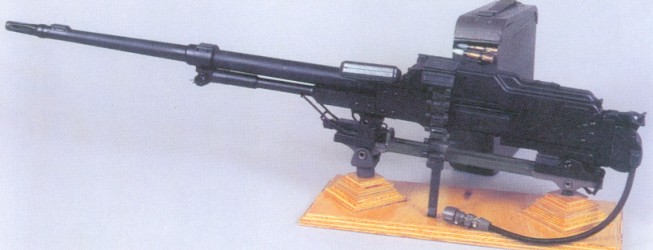
PKT Machine gun
Known issues
Apart the usual uncomfortable and crampy interior that would be unacceptable for NATO crews, the T-80BV used in combat in Chechnya was proven quite vulnerable and prone to catastrophic explosions. The reason given by US and Russian experts was the vulnerability of stored semi-combustible propellant charges and missiles when hit by molten metal jet from the penetrating HEAT rounds. Western tank indeed had their rounds stored in a separate stowage from the crew compartment, using with armored blast doors, 'blow-out' panels. The latest T-84 Oplot, the Ukrainian derived version of the T-80 has an entirely new turret with armored ammunition compartment to help prevent accidental detonation.
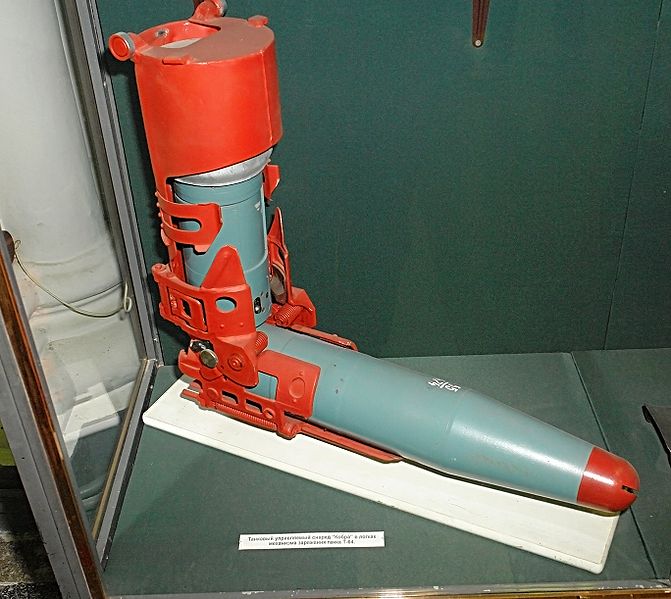
125 mm 9K112 Kobra gun ATGM
The T-80B (1978)
This first evolution of the basic type came quickly and was characterized by a new turret integrating new laser rangefinder, fire-control, even a new autoloader modified to operate the 9M112-1 Kobra ATGM. This one was credited for accurate 80% hits on the move. On the protection side, improved composite armor was used.In 1980 this version received a 1,100-hp engine. In 1982 it was provided with a new gun.
In 1985, it received fittings for an improved reactivearmorr. This had an equivalent protection of 400 mm against HEAT warheads. Sighting range for the ammunitions range from 4000 m for kinetic energy ammunitions cumulative ammunition, 5000 m for HE-frag and near 10,000 when using the "side level" system. The night sight TPNZ-49 range in active mode was 1300 and 850 m in passive mode. Accuracy for the "Reflex" ATGMs system in enhanced by a laser beam allows for accurate targeting on the move at any speed.
The T-80BV/UM (1985)
In addition to the modifications seen above, the BV introduces a new ERA (Explosive Reactive Armour), and the UM is given the new Buran Thermal Imaging sight in place of the Luna IR.The T-80U (1985)
The T-80U ("U" stands for uluchsheniye, meaning "improved") was designed by SKB-2 in Leningrad for the hull, working with the Morozov Bureau for the turret and armament. The T-80U uses the Kontakt-5 explosive reactive armour (see later), had an improved gunsight, and the 9K119 Refleks ATGM (from 1990).A development of the T-80A, it was powered from 1990 by a 1,250 hp (919 kW) GTD-1250 gas turbine, for improved range. The latter was derived from the GTD-1000T and GTD-1000TF engines used by the main production T-80s. This new gas turbine was mutifuel, accepting high-octane aviation gasoline as well as diesel and low-octane gasoline. It was also very reliable, stable for a better service life. It also had a built-in automatic system of dust deposits removal but still retains a relatively high fuel consumption. The main gun was provided with the 2A46 fire control system in an improved turret. For amphibious crossings, it was given the new Brod-M deep wading equipment.
The T-80U was preceded by the Object 219AS prototype, a transitional model which used the T-80U turret, but Kontakt-1/ERA instead of the new Kontakt-5. Some of these Object 219As even shows no ERA at all. The commander version (T-80UK)is equipped with the Shtora-1 APS and the thermal imaging night sight TO1-PO2T (about 6400/4600 meters night range). By comparison the base thermal night sight is about 1750/1500 meters.
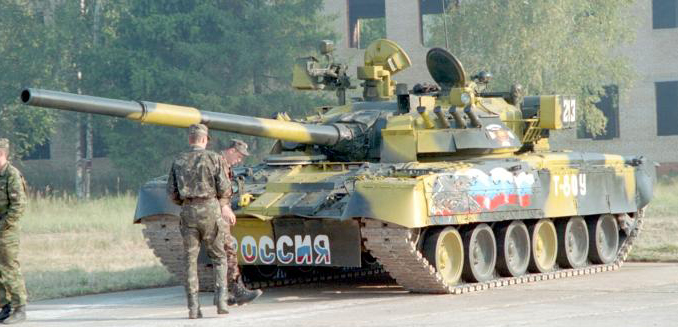
T-80U 2002 in Kubinka
In terms of protection, The T-80U featured a second generation of explosive reactive armour (ERA) Kontakt-5, well proven against APFSDS rounds, which can largely dissipate the energy from the M829A1 "Silver Bullet". Kontakt-5 was also integrated to the hull. It gave an equivalent of 780/1320 mm RHAe against APFSDS/HEAT rounds. It has full length rubber side skirts to protect the sides, the first three being rigid, armored, and provided with lifting handles.
The commander's machine gun is a simple pintle-mounted one. The 9M119 Refleks (AT-11 Sniper) guided missile are provided for the main gun, each having a Long-Rod penetrator (HVAPFSDS) 3BM46. For active concealment, outside the smoke projectors, a special camouflage paint distorts the tank's appearance in the visible and IR wavebands. The 1A46 fire control system includes a laser range finder, ballistics computer, advanced 1G46 gunner's main sights, and thermal imaging sights.
These new systems, together with the 125 mm D-81TM "Rapira-3" smooth bore gun, ensures that the T-80U can accurately hit and destroy targets at a range of up to 5 kilometers (ATGMs and HV/APFSDS). Experienced crew was able to successfully at the international exhibition missile to strike 52 targets without a miss at a distance of 5 km.
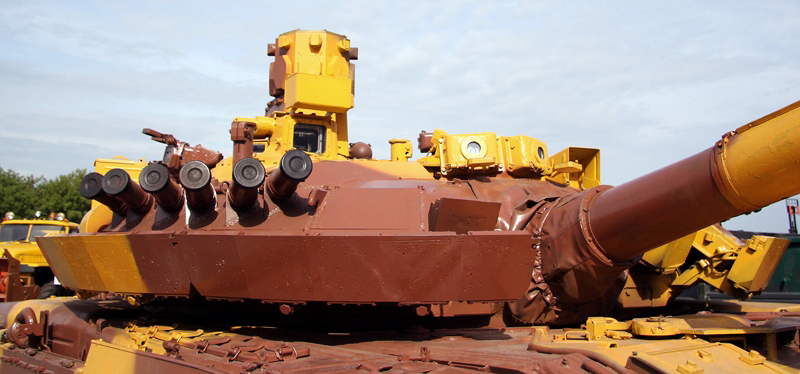
T-80UM-1 exposed at Omsk, 2009.
T-80 UM (1990)
The T-80U(M) of the 1990s introduced the TO1-PO2 Agava gunner's thermal imaging sight and 9M119M Refleks-M guided missile, and later an improved 2A46M-4 version of the 125 mm gun and 1G46M gunner's sight was used. Both the T-80 poor combat performances and high fuel consumption conducted the Russian command to standardize the T-90 tank. The Omsk Tank Plant in Siberia since with that decision was left without orders but try to sell the T-80 on the export market. South Korea and China imported it in small numbers, as well as pakistan and Cyprus. The T-80UM1 was in that perspective intended for export only, given active protection systems from the T-80UM2 Black Eagle.T-80UD Bereza (Ukraine, from 1987)
Morozov Bureau developed a diesel-powered version called the T-80UD, powered by a 1,000-hp 6TD-1 6-cylinder multi-fuel two-stroke turbo-piston diesel engine. This allowed operational fuel temperatures up to 55 °C and to ford to 1.8 m water depth. The engine deck and smoke-mortar array, turret stowage boxes are all different from the Russian-built T-80U. The remotely controlled commander's machine gun is also part of the package.500 were built in the Malyshev plant in 1987-1991, a potent addition for the Ukrainian Military after the breakup of USSR. Alongside the derived T-84, this tank is today the staple of Ukrainian MBT force and will remains so in future years.
Other variants
T-84 (Ukraine 1999): Further development with a 1,200-hp diesel, new welded turret.T-80BVD (Ukraine, 2002): KMDB's upgrade which includes the 6TD diesel engine, remote-controlled commander's machine gun, better optics. It remains at a demonstrator but non was sold yet. Chonma-ho V
North korean T-80U
T-80UM2/Black Eagle tank: Cancelled project. Several Russian prototypes shown at trade shows, with a longer chassis and extra pair of road wheels, and very large turret with separate ammunition compartment.
Exports
Armenia: 20 in service.Belarus: 95 in 2000, 90 today.
Cyprus: 27 T-80Us & 14 T-80UKs ordered in 1996, 25 T-80Us and 16 T-80UKs later -Total 82
Egypt: 14 T-80UKs, 20 T-80Us acquired 1997.
South Korea: 33 T-80Us ordered in 1995, two T-80UKs in 2005, now retired.
Pakistan: 320 T-80UDs ordered 1996 from Ukraine, last delivered 2002. They integrated many technologies common to the T-84.
People's Republic of China: 50 (200 ordered in 1993) T-80Us obtained for evaluation used for the development of the Type 96 MBT.
Russia: 3,144 active, 1,856 in storage 1995, only 271 active in 2005.
Yemen: 31 ex-Russian delivered in 2000.
Bulgaria also tested the type in the late 1980s but after comparison with the latest versions of the T-72 rejected the design. Some sources also states that Kazakhstan also purchased some, without precision. According to most trusted sources however only T-72 MBTs of various types are currently in service. Also in 1992, the UK bought a number of T-80U tanks for defence research and development through a specially created trading company intended to deliver these to Morocco, offering five million USD each.
After being evaluated on their proving grounds one was transferred to the US, tested at Aberdeen Proving Ground (and later four Ukrainian T-80UD MBTs). Weak spots and flaws were duly noted. This was officially confirmed in January 1994 by the MOD. South Korean tanks were given in order to pay Russian debts incurred during the days of the Soviet Union. Russia also attempted to sell the T-80 to Turkey and Greece. Sweden also integrated the T-80 in the competition to modernize its armoured brigades in the early 1990s alongside the Leclerc but the upgraded Leopard 2 (Strv 122) was chosen instead and Leopard 2A4s (Strv 121) kept to simplify logistics.
The T-80 in action
The T-80 entered service in the early 1980, very gradually due to repeated teething problems. 1,900 were registered in service in 1985, 4,000 in 1990, and 4,839 during the breakup of the USSR, since passed to successors states (Ukraine, Belarus and Kazakhstan), stored and exported. T-80Us were never deployed in Europe. Instead T-80B and T-80BVs were stationed in East Germany between 1986 and 1987. Their speed led concerns to NATO that the whole Soviet armoured brigades could reach the sea in less than two weeks, and led to the development of new ATGMs and attack helicopters.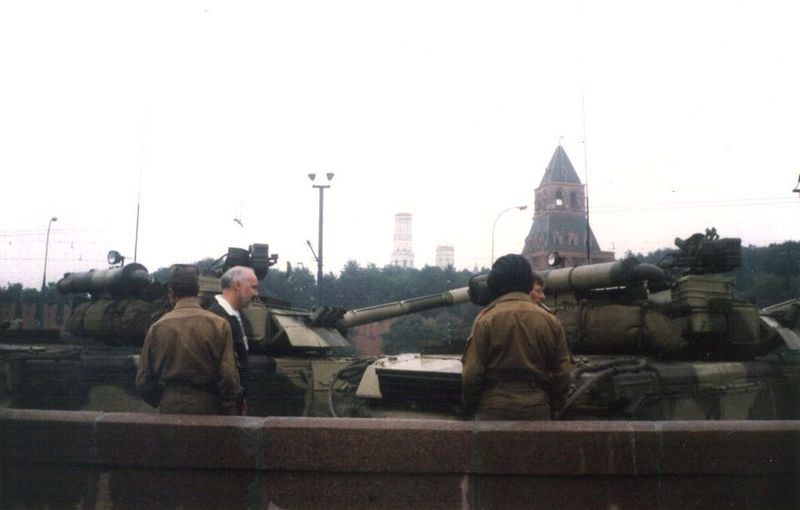
T-80Us at the 1991 Moskow coup attempt.
But instead of the great rush on the open plains of Eastern Europe, T-80s were deployed in August 1991 when communists and allied military commanders tried to overthrow Mikhail Gorbachev. T-80UD of the 4th Guards Kantemirovskaya Tank Division were launched into the streets of Moscow to no avail as the coup attempt failed as crews refused to fire on the audience and parliament (see above). After that about 460 T-80UD are retained in service with 2nd Guards Tamanskaya Motor Rifle Division and 4th Guards Kantemirowsk Motor Rifle Division. It's still a costly tank to operate. In the 1993 Russian constitutional crisis, (4 October) six T-80UD MBTs -12th Guards Tank Regiment & 4th Guards Kantemirovskaya Tank Division- took positions on a bridge opposite the Russian parliament and fired on it. Also in July 1998, a single T-80 (Major Igor Belyaev) went in front of the administration building of Novosmolensk, aiming at it in protest of several months of unpaid wages.
The Chechen war: Humiliation and Controversy
The real test came with T-80B and BVs deployed (without success) for capturing rebellious cities. Massive tank losses were suffered in particular in Grozny. Crews were not trained nor prepared to face opposing veterans of the Soviet War in Afghanistan, very mobile and well armed with RPG-7V and RPG-18s. They lacked reactive armour or were not fitted with explosive inserts. It was even discovered some "boxes" were left empty. Anti-tank fire was judiciously directed at the least armoured points of the vehicles, if needed with as many hits as necessary.
In general three to six RPG hits were sufficient to disable T-80s, and it was observed that most time the autoloader was the weak spot because of penetrating hits in their side armour, blewing stored ready propellant in a vertical position. They were supposed to be protected by the road wheels from the sides, but most of the times, rebels were posted in cellars and in general dominant positions or at the contrary from basements, whereas T-80s suffered from minimal gun elevation and depression and were unable to respond.
225 tanks in all were destroyed in the first month alone (about 10% of tanks deployed for thos campaign). This led General-Lieutenant A. Galkin (head of the Armor Directorate) to convince the MOD after the war to stop any delivery or procurement of gas-turbine propelled tanks. This led to new tactical assignments, like infantry squads support from a safe distance. On the other hand, some officers argued that the T-72s deployed in urban areas performed as poorly and anyway the crews sent has not been trained properly to face these missions, nor had the right tactics. As a result T-80s were excluded from the operations in the second Chechen war, and the war in Ukraine. It is not known what the future reserves to the T-80. New offensive actions could come from foreign deployments, since its use in Russia has dwindled down to symbolic numbers, but nothing is closed so far for the Ukrainian ones, not modernized to the latest T-84 level and still in considerable numbers.
Links and ressources
The T-80 on wikipediaThe T-80U at fprado.com
The T-80 on militaryfactory
The T-80U on army-technology
The T80UD at Morozov website
The T80 on armyrecoignition.net
Object 480 walkaround
T-80BV walkaround
The T-80UD on militaryfactory
More T-80 photos on wikimedia commons
An article about the Chechen losses - nationalinterest
T-80U on wikimedia commons
T-80BV on wikimedia commons
T-80B on wikimedia commons
Video
T-80B specifications |
|
| Dimensions (L-W-H) | 9.9m (7.4m without gun) x 3.4m x 2.2m (32'5" (24'3") x 11'1" x 7'2" ft.in) |
| Total weight, battle ready | 42.5 to 46 tons |
| Crew | 3 (driver, cdr, gunner) |
| Propulsion | SG-1000 gas turbine - 23.5 hp/tonne |
| Suspension | Active hydropneumatic suspensions |
| Speed (road) | 89 km/h (55 mph) |
| Range | 320 km (200 mi) |
| Main Armament | 2A46 125 mm gun |
| Armor | 450-650mm equivalent vs APFSDS & HEAT |
| Total production | 5404 in 1995 |
Gallery
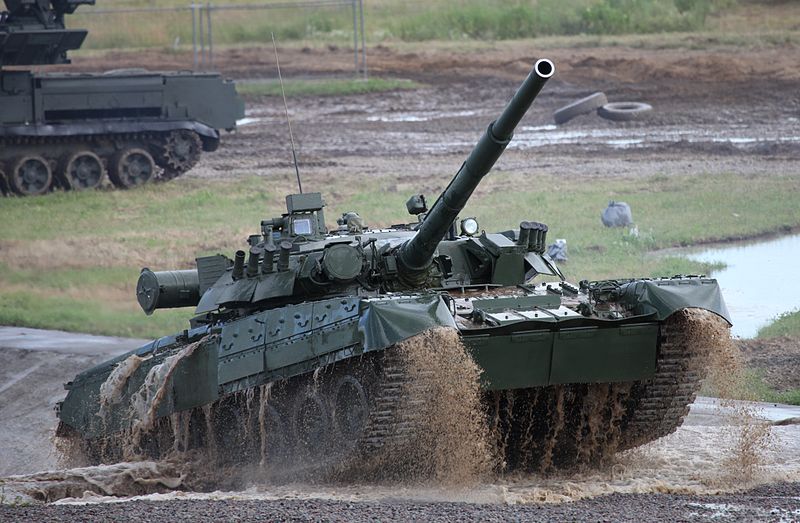
T80U @Engineering Technologies 2012
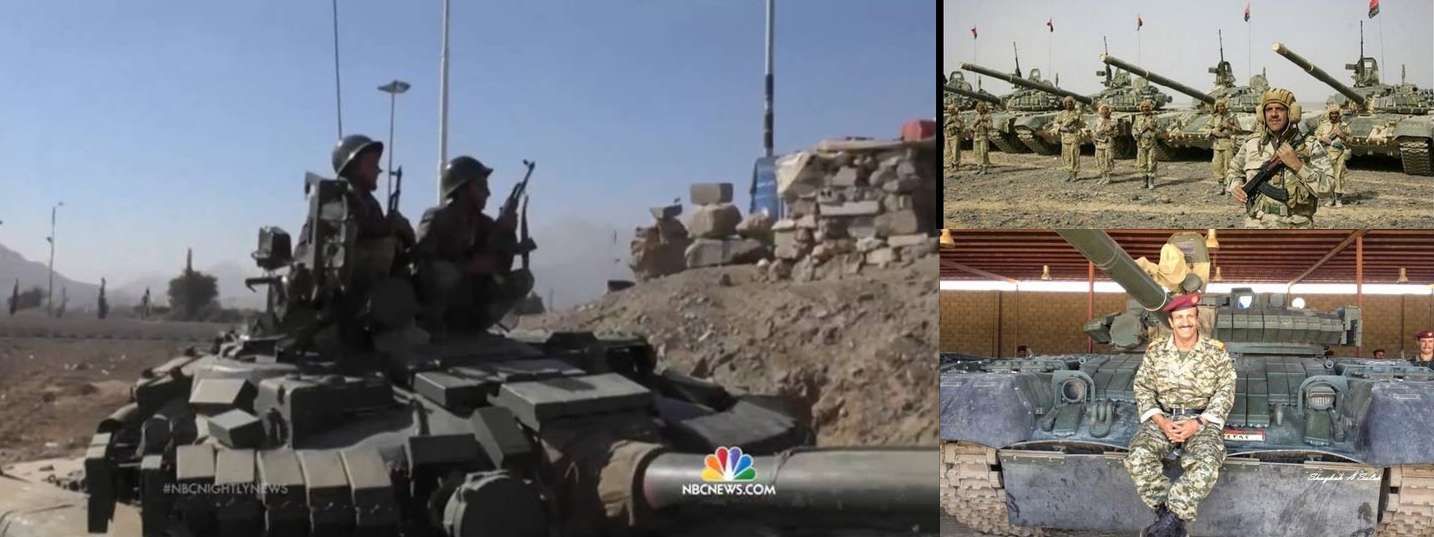 Yemeni T-80BV on display
Yemeni T-80BV on display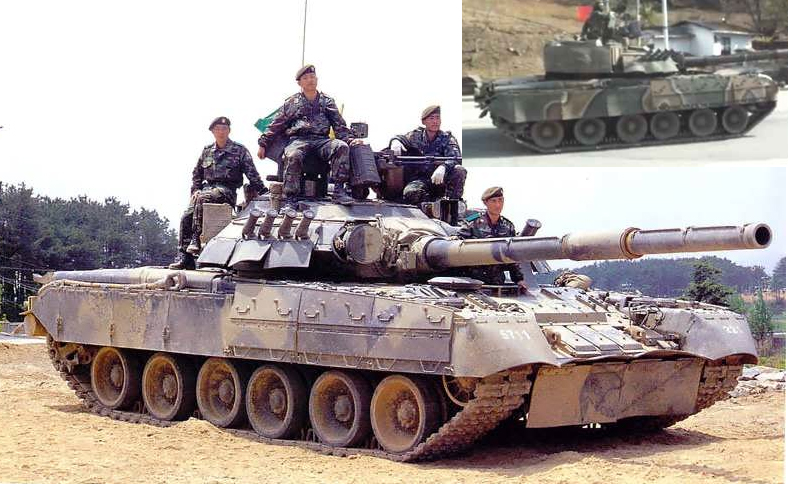
South Korean T-80U
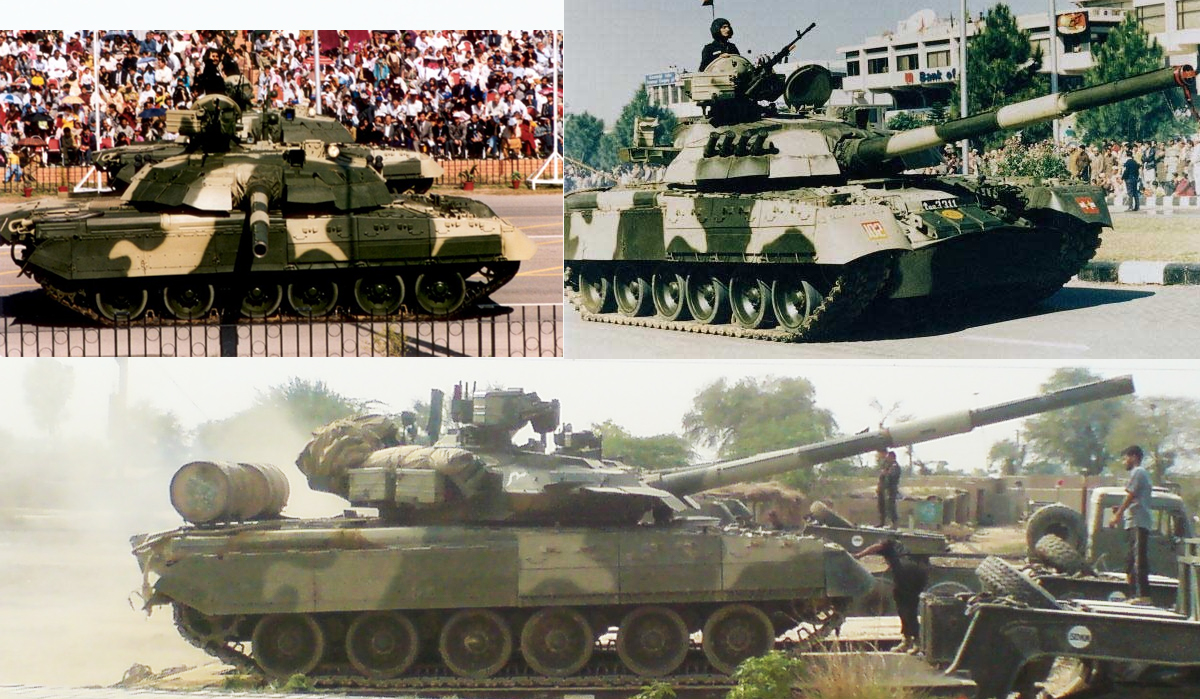
Pakistani T-80U
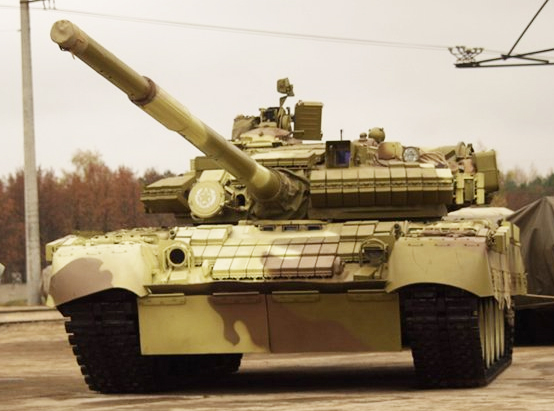
T-80BV intended for egypt
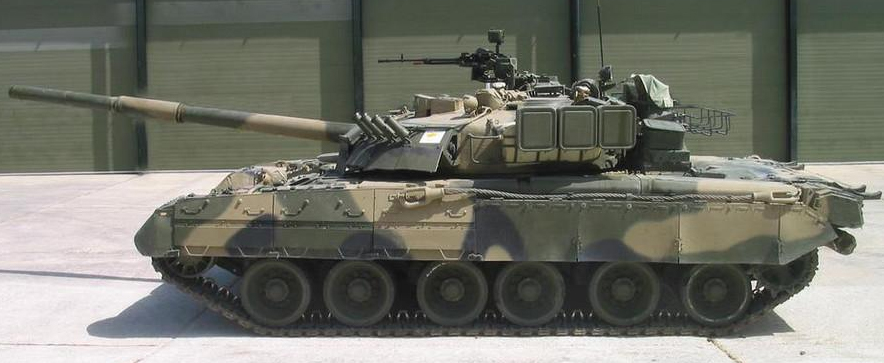
Cypriot T-80U
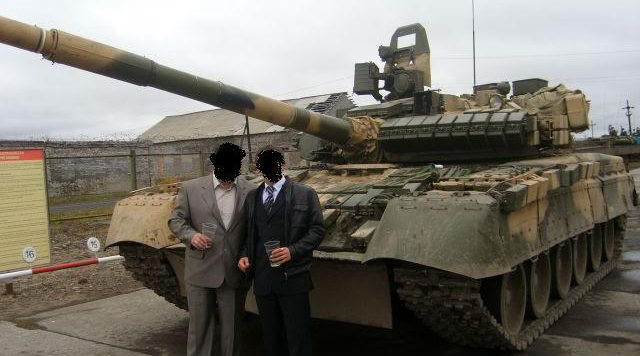
Armenian T-80BV
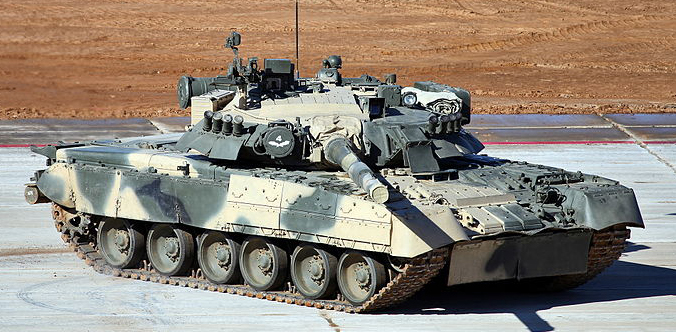
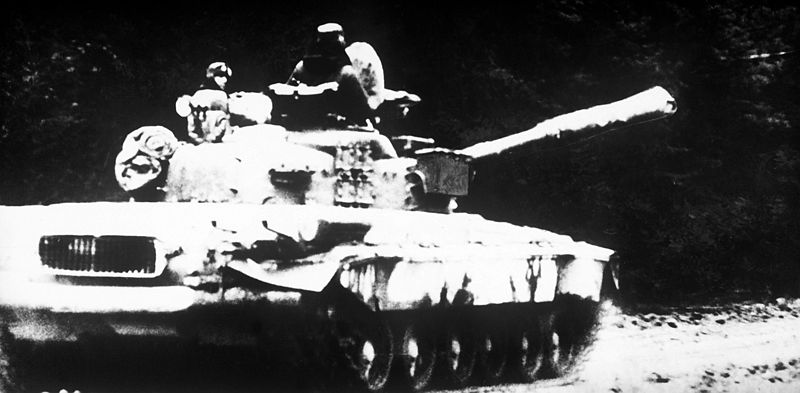
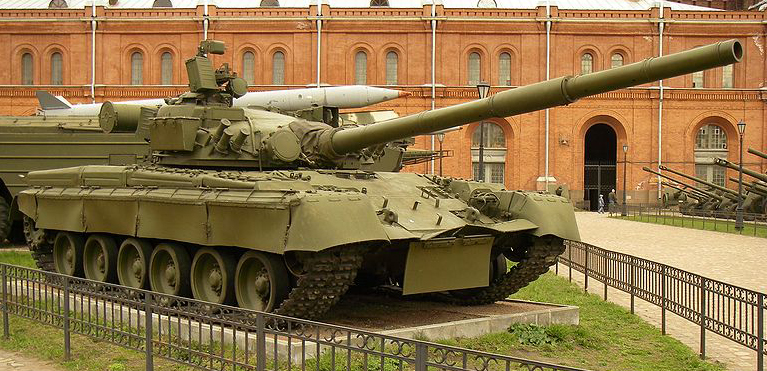
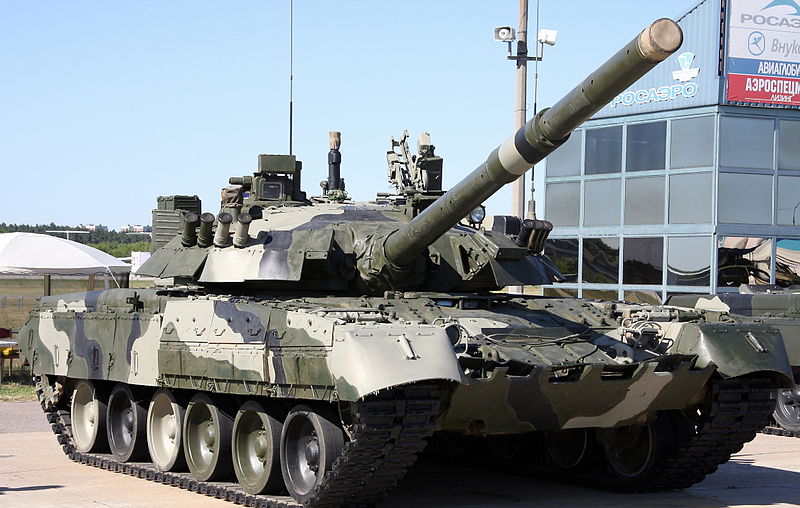
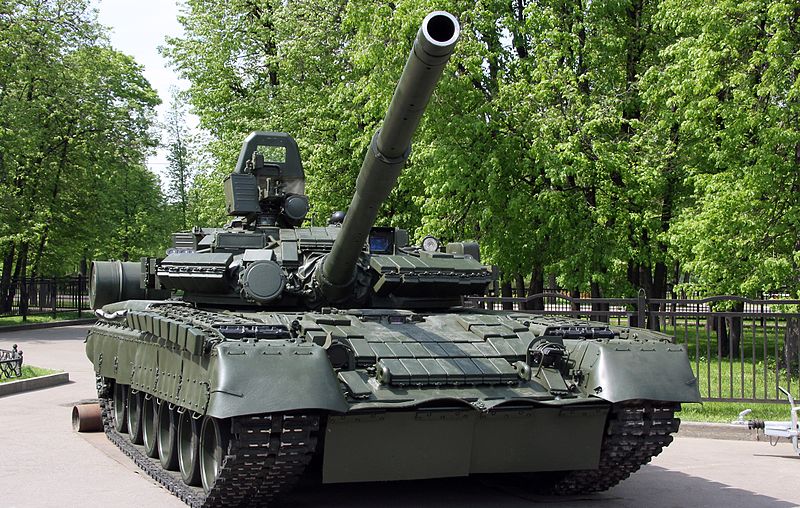
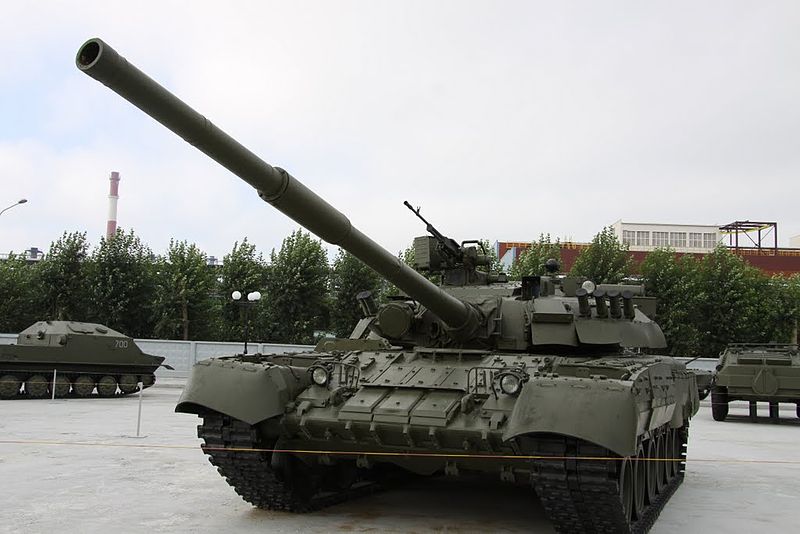
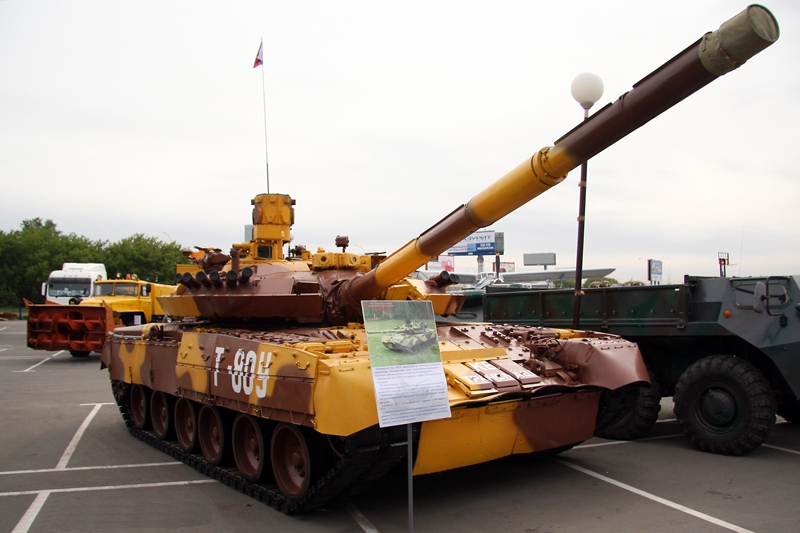
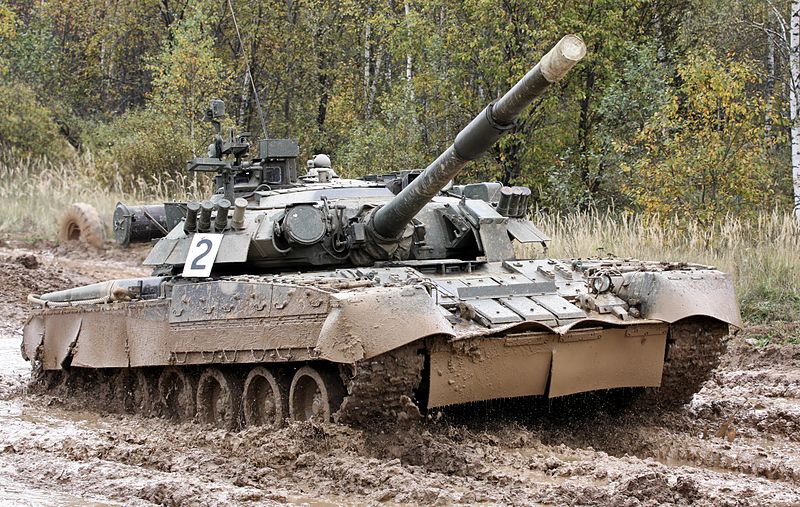
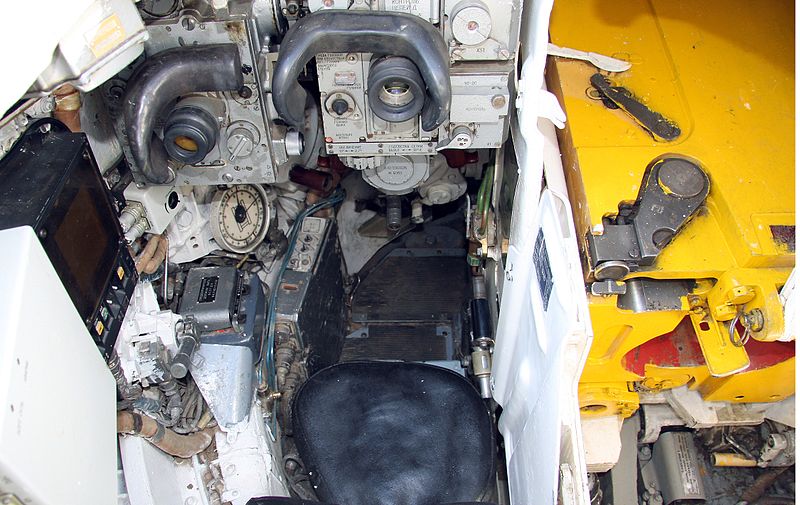
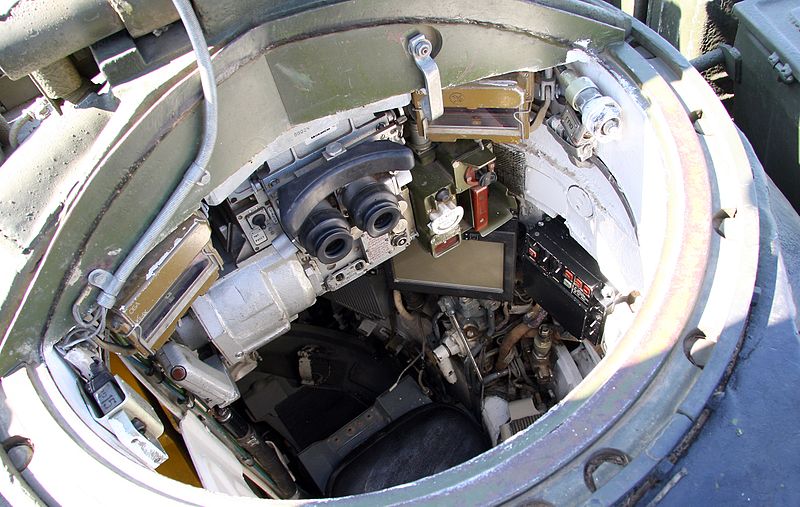
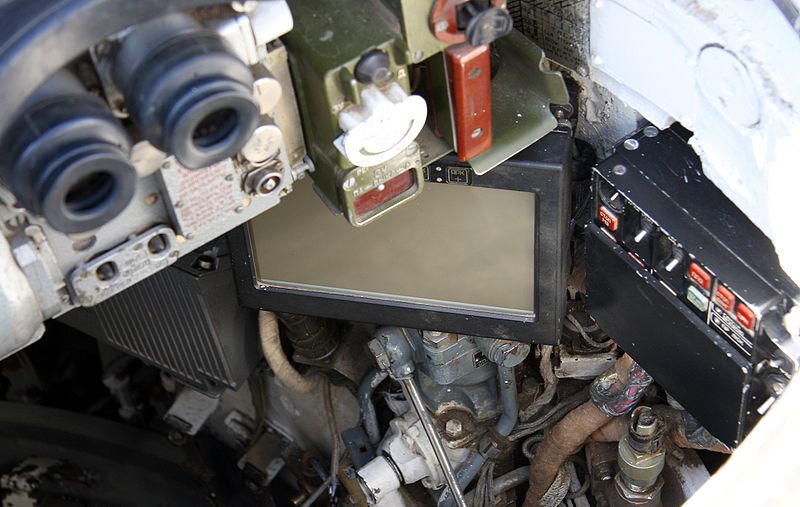
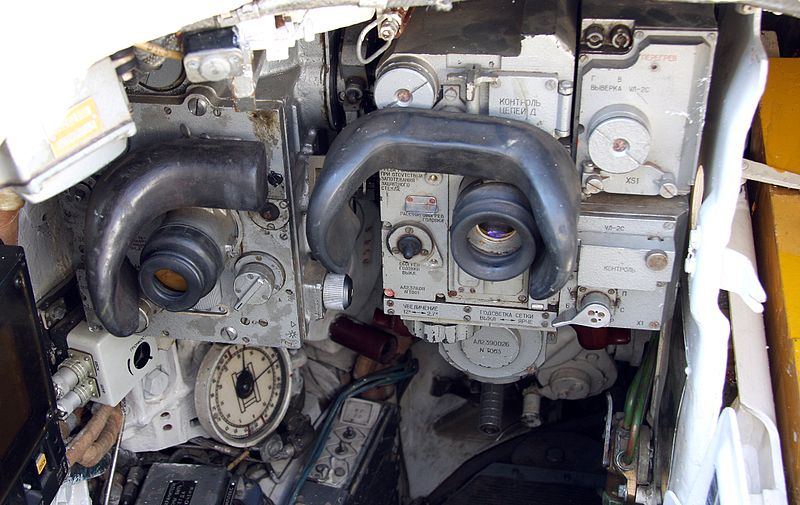
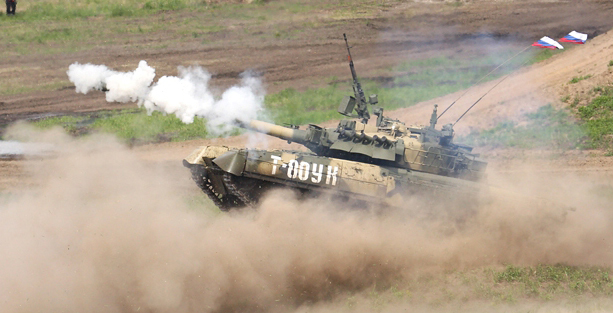
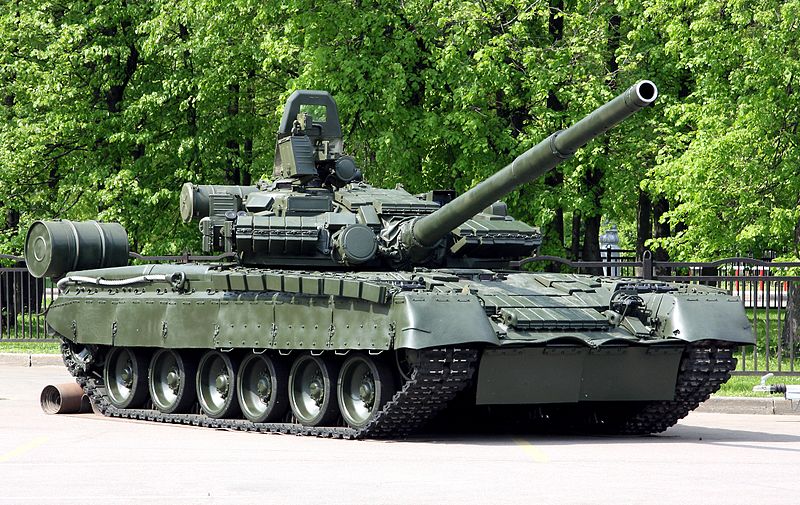
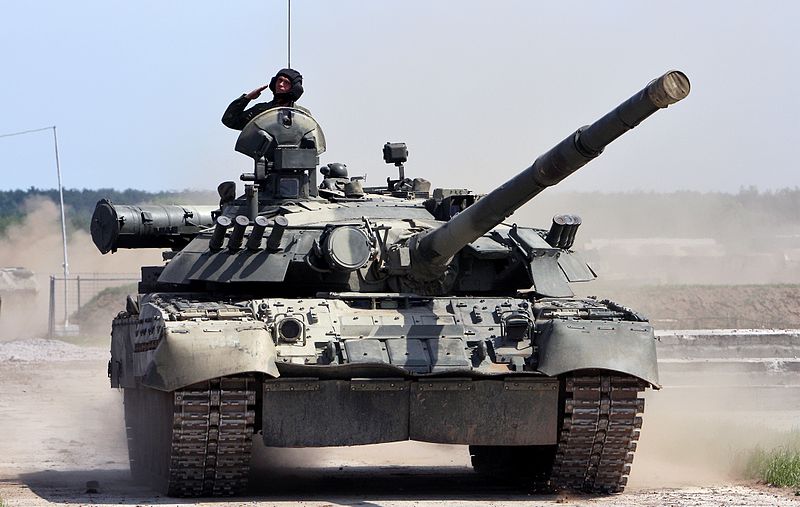
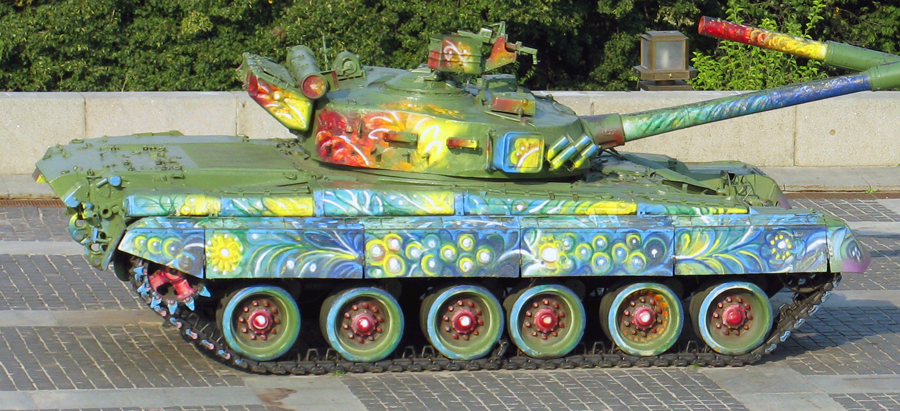

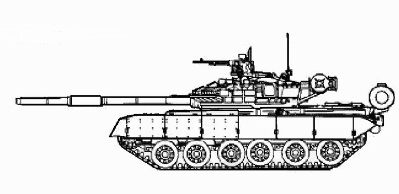
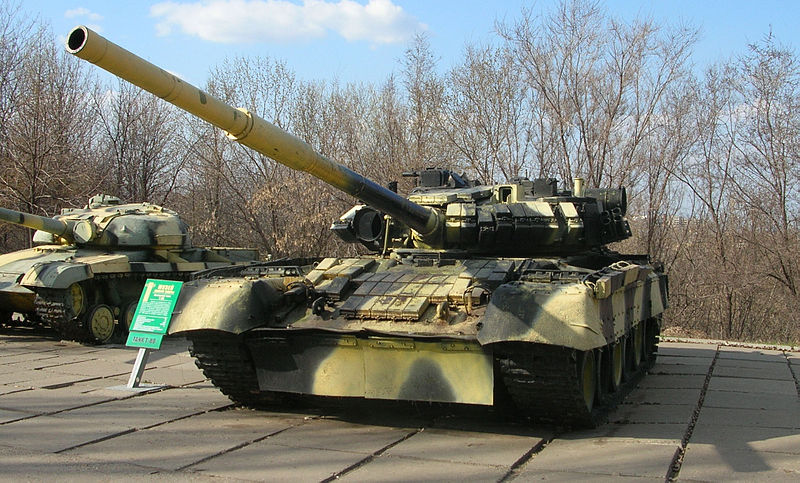
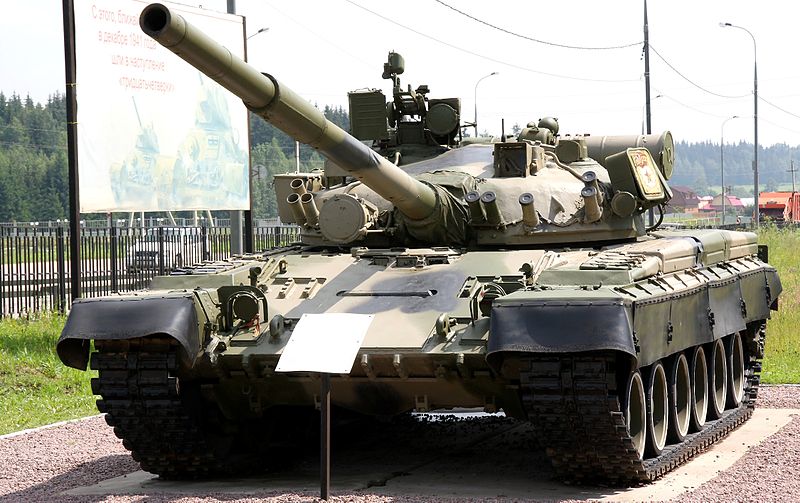
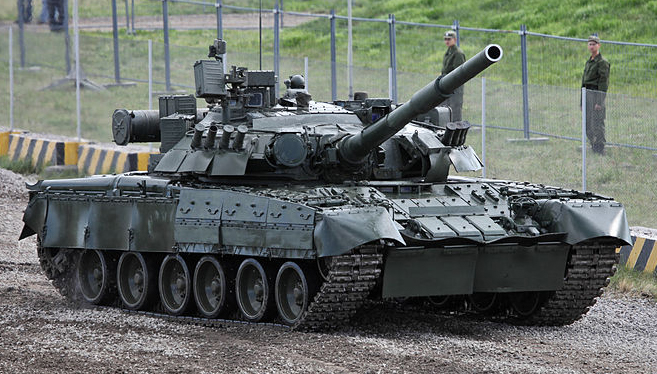
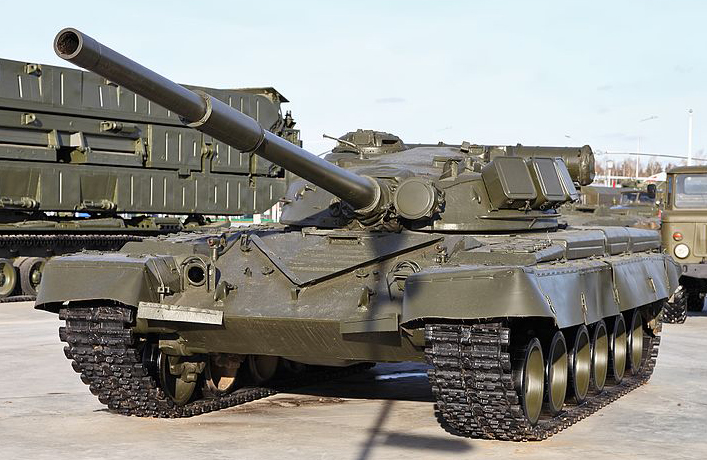
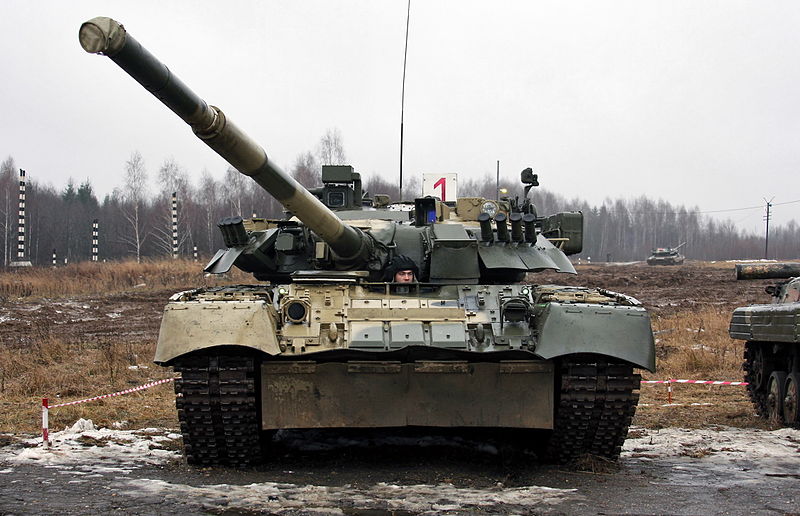

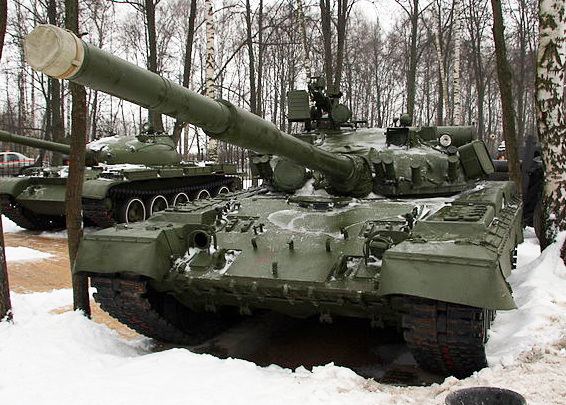
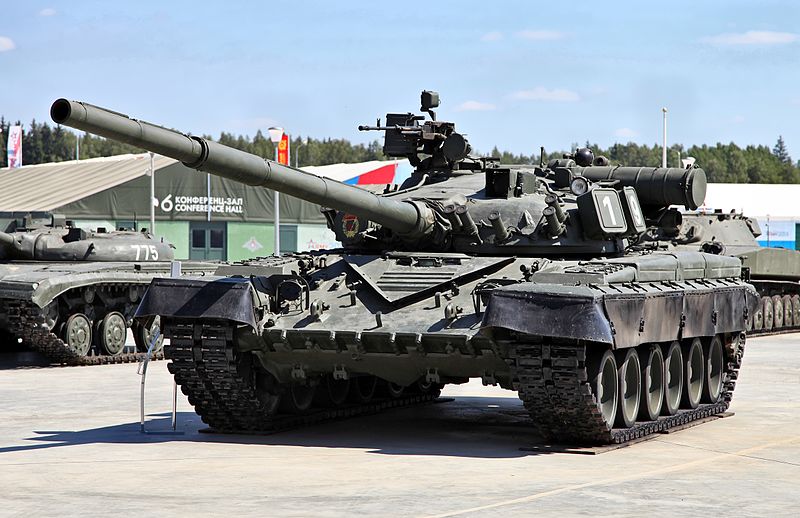
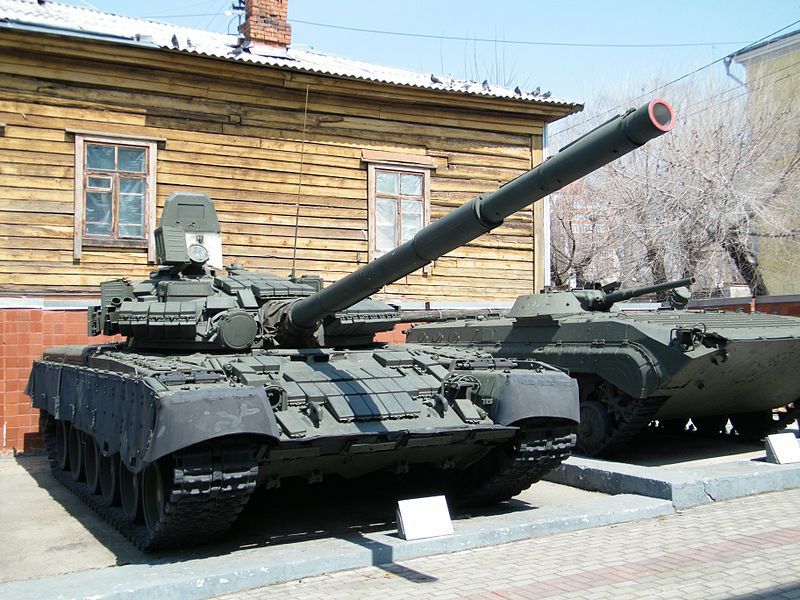
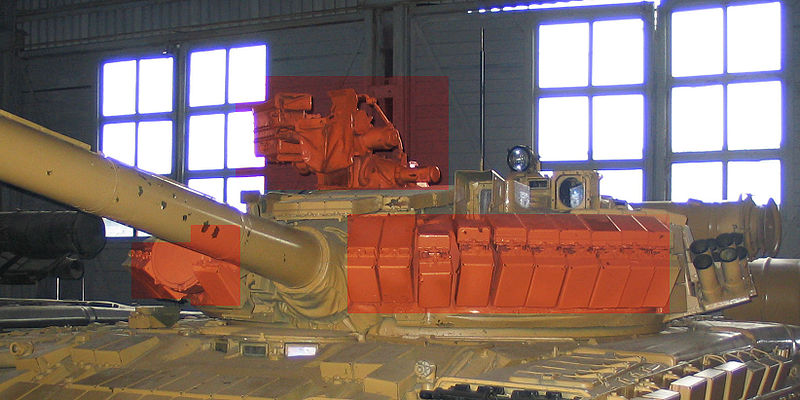
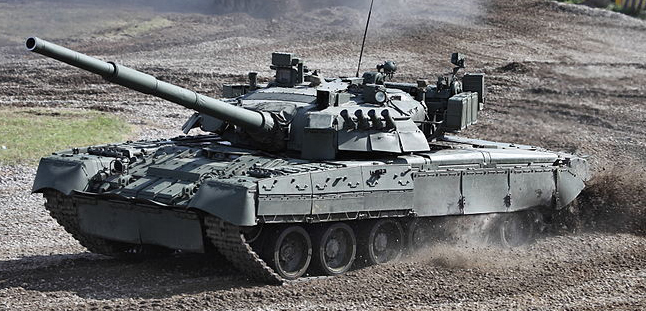
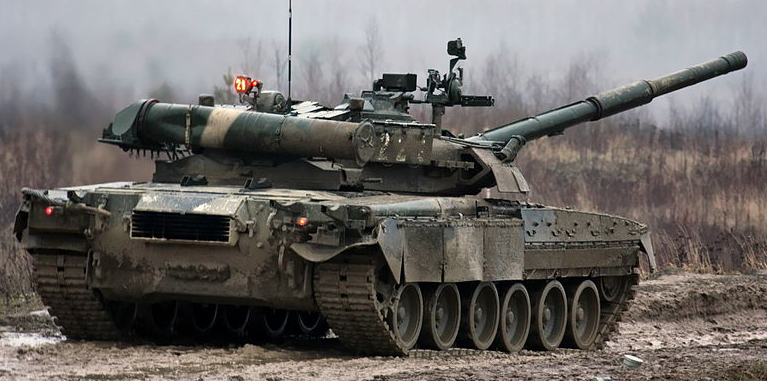
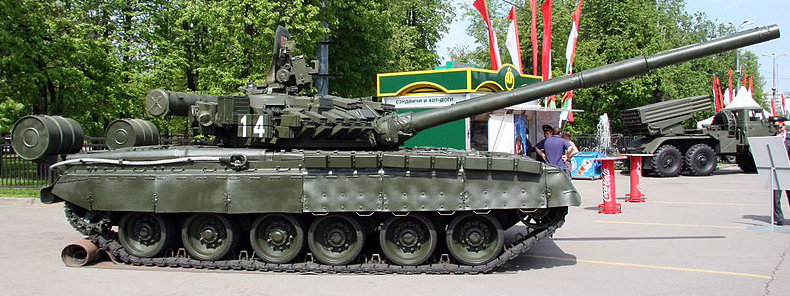
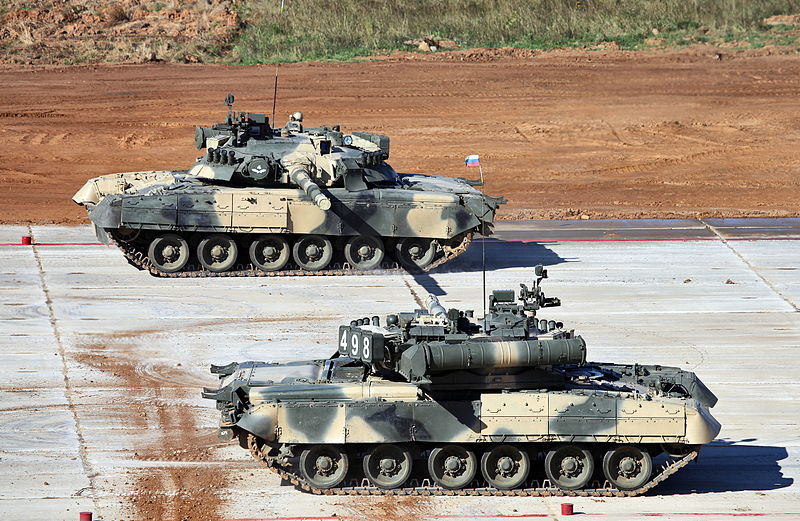
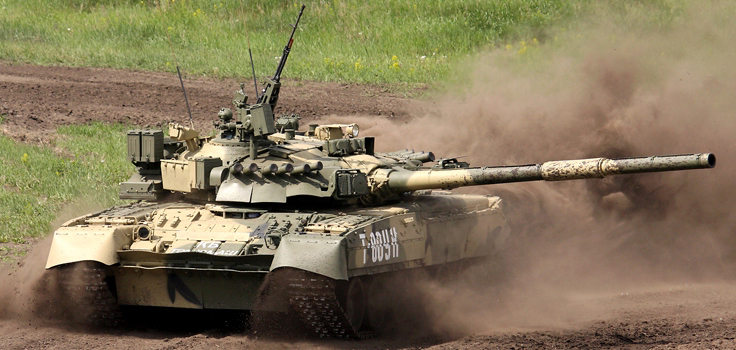
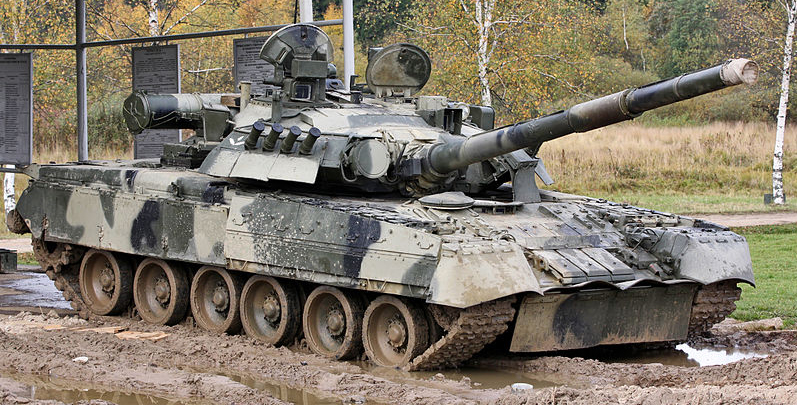
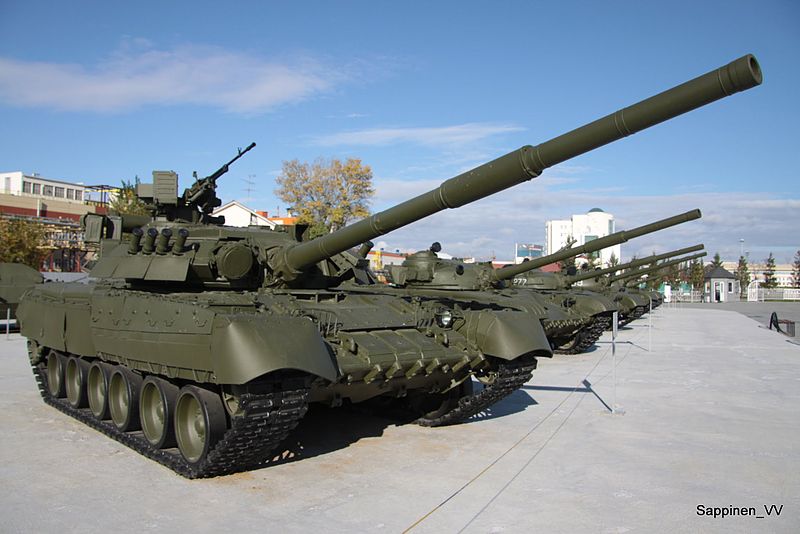

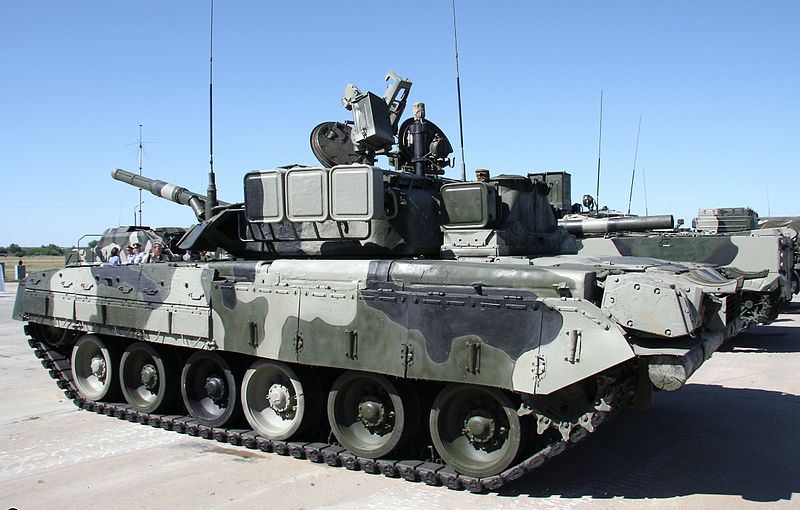

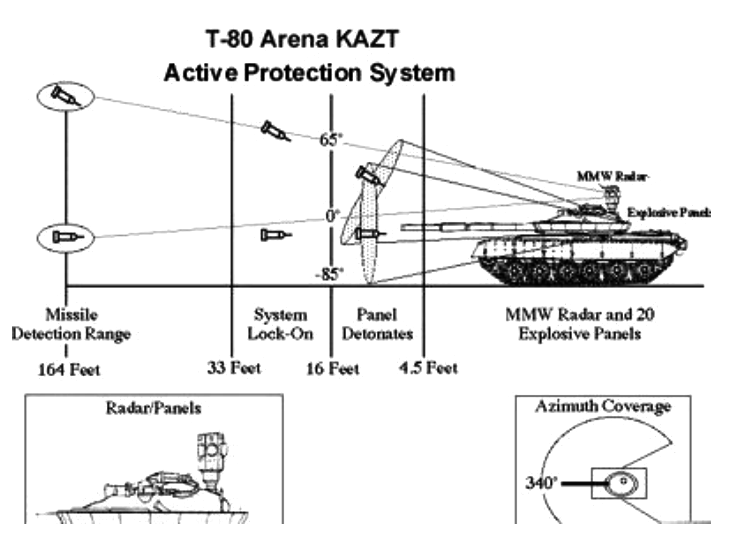
Authir's illustrations
 Soviet T-80, early preseries, 1970s
Soviet T-80, early preseries, 1970s
Soviet T-80, late 1970s

Soviet T-80 early 1980s

Soviet T-80B, 1978

Soviet T-80B, 1980s

Soviet T-80 BV, 1980s

Russian T-80BV, 1990s

Russian T-80 BV in Grozniy, 1994

T-80 BV in Transnistria, 1996

Russian T-80BV

Russian T-80BV

T-80 BVD
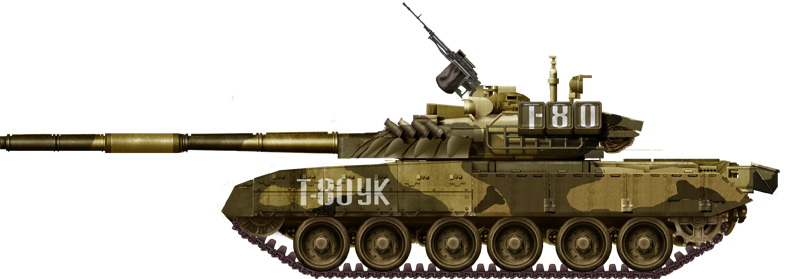
T-80 UK, official presentation prototype

Russian T-80 BU
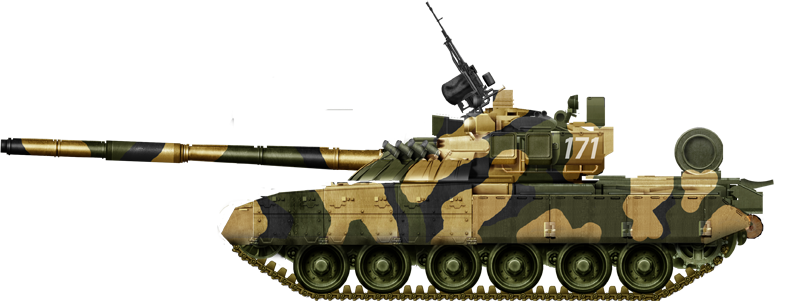
Russian T-80U Guard Kamtemirovets, Moskow, 1991

Pakistani T-80U
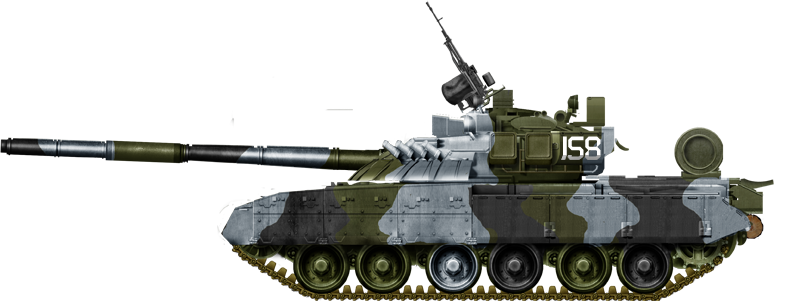
Russian T-80U, 2001

Russian T-80UK
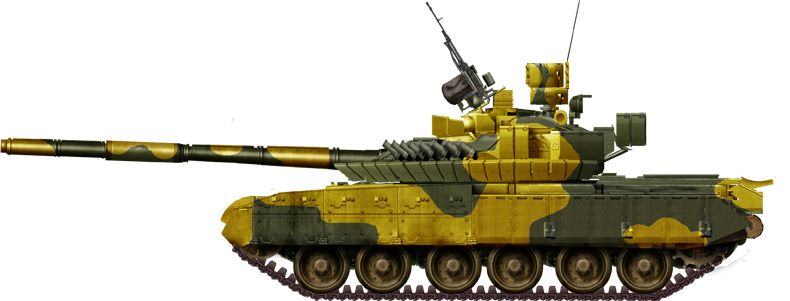
Russian T-80UM

Cold War Tanks


































Cold war tanks posters

Cold War Main Battle Tanks

Cold War Soviet Army

